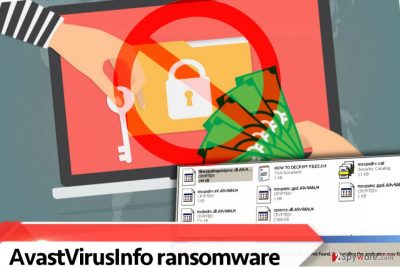AvastVirusinfo ransomware / virus (Virus Removal Instructions) - Improved Instructions
AvastVirusinfo virus Removal Guide
What is AvastVirusinfo ransomware virus?
AvastVirusInfo ransomware corrupts victim’s files for good, but still wants a ransom
AvastVirusInfo virus is a scammy and malicious program, which poses as a working ransomware[1] meanwhile it is a poorly programmed piece of malware. It has been discovered that AvastVirusInfo malware is a new version of Xorist ransomware.[2] Just like any other ransomware, AvastVirusInfo encrypts[3] nearly all files on the system and then asks the victim to pay a ransom, however, even if the victim does so, the virus authors will NOT provide the decryption key. This virus completely damages files and makes them useless, so do not waste your money by paying the ransom to cyber criminals. The ransomware targets Russian-speaking users and can be recognized from file extensions that it adds to each encrypted file – this particular virus appends .[8 random chars] extension to every corrupted record.

How can I get infected with this virus?
AvastVirusInfo ransomware is dangerous, and you should do everything to stay away from it. Such viruses are mostly distributed via email, pirated software packs, or compromised websites[4]. The best way to protect yourself from ransomware viruses is to install and always fulfill your anti-malware software with the latest updates, as well as have a data backup to use in case a ransomware manages to slip into your PC. You can avoid ransomware by not opening suspicious emails sent by strangers, also not browse shady third-party websites. Sadly, it gets harder and harder to keep up with the latest malware distribution tricks and recognize phishing[5] or compromised websites, so we assume the anti-malware software is the key to a safe computer.
How can I remove AvastVirusInfo virus from the system?
You will have to use instructions provided below this article to remove AvastVirusInfo virus. We want to say that it is going to be hard to remove the virus, so be patient. We want to remind you that there is no point in paying the ransom because cyber criminals technically cannot provide it due to a bug in the virus code. Therefore, you should start AvastVirusInfo removal this way:
Getting rid of AvastVirusinfo virus. Follow these steps
Manual removal using Safe Mode
You can remove ransomware easily when the computer is running in a Safe Mode with Networking. However, if this method doesn’t work for you, try method 2 instead.
Important! →
Manual removal guide might be too complicated for regular computer users. It requires advanced IT knowledge to be performed correctly (if vital system files are removed or damaged, it might result in full Windows compromise), and it also might take hours to complete. Therefore, we highly advise using the automatic method provided above instead.
Step 1. Access Safe Mode with Networking
Manual malware removal should be best performed in the Safe Mode environment.
Windows 7 / Vista / XP
- Click Start > Shutdown > Restart > OK.
- When your computer becomes active, start pressing F8 button (if that does not work, try F2, F12, Del, etc. – it all depends on your motherboard model) multiple times until you see the Advanced Boot Options window.
- Select Safe Mode with Networking from the list.

Windows 10 / Windows 8
- Right-click on Start button and select Settings.

- Scroll down to pick Update & Security.

- On the left side of the window, pick Recovery.
- Now scroll down to find Advanced Startup section.
- Click Restart now.

- Select Troubleshoot.

- Go to Advanced options.

- Select Startup Settings.

- Press Restart.
- Now press 5 or click 5) Enable Safe Mode with Networking.

Step 2. Shut down suspicious processes
Windows Task Manager is a useful tool that shows all the processes running in the background. If malware is running a process, you need to shut it down:
- Press Ctrl + Shift + Esc on your keyboard to open Windows Task Manager.
- Click on More details.

- Scroll down to Background processes section, and look for anything suspicious.
- Right-click and select Open file location.

- Go back to the process, right-click and pick End Task.

- Delete the contents of the malicious folder.
Step 3. Check program Startup
- Press Ctrl + Shift + Esc on your keyboard to open Windows Task Manager.
- Go to Startup tab.
- Right-click on the suspicious program and pick Disable.

Step 4. Delete virus files
Malware-related files can be found in various places within your computer. Here are instructions that could help you find them:
- Type in Disk Cleanup in Windows search and press Enter.

- Select the drive you want to clean (C: is your main drive by default and is likely to be the one that has malicious files in).
- Scroll through the Files to delete list and select the following:
Temporary Internet Files
Downloads
Recycle Bin
Temporary files - Pick Clean up system files.

- You can also look for other malicious files hidden in the following folders (type these entries in Windows Search and press Enter):
%AppData%
%LocalAppData%
%ProgramData%
%WinDir%
After you are finished, reboot the PC in normal mode.
Remove AvastVirusinfo using System Restore
This is the second method for those trying to remove AvastVirusInfo ransomware. This is what you should do:
-
Step 1: Reboot your computer to Safe Mode with Command Prompt
Windows 7 / Vista / XP- Click Start → Shutdown → Restart → OK.
- When your computer becomes active, start pressing F8 multiple times until you see the Advanced Boot Options window.
-
Select Command Prompt from the list

Windows 10 / Windows 8- Press the Power button at the Windows login screen. Now press and hold Shift, which is on your keyboard, and click Restart..
- Now select Troubleshoot → Advanced options → Startup Settings and finally press Restart.
-
Once your computer becomes active, select Enable Safe Mode with Command Prompt in Startup Settings window.

-
Step 2: Restore your system files and settings
-
Once the Command Prompt window shows up, enter cd restore and click Enter.

-
Now type rstrui.exe and press Enter again..

-
When a new window shows up, click Next and select your restore point that is prior the infiltration of AvastVirusinfo. After doing that, click Next.


-
Now click Yes to start system restore.

-
Once the Command Prompt window shows up, enter cd restore and click Enter.
Bonus: Recover your data
Guide which is presented above is supposed to help you remove AvastVirusinfo from your computer. To recover your encrypted files, we recommend using a detailed guide prepared by 2-spyware.com security experts.Most likely you won’t able to recover your files once the virus encrypts them. However, you can still try one of these methods to restore your data. Ideally, use a data backup – this way, you will recover the vast of your files.
If your files are encrypted by AvastVirusinfo, you can use several methods to restore them:
Data Recovery Pro. Method 1
You can try to run Data Recovery Pro to see if you can recover some of the lost files.
- Download Data Recovery Pro;
- Follow the steps of Data Recovery Setup and install the program on your computer;
- Launch it and scan your computer for files encrypted by AvastVirusinfo ransomware;
- Restore them.
Windows Previous Versions. Method 2
If you created a system restore point a while ago, using this method can help to recover some files. This is what you should do:
- Find an encrypted file you need to restore and right-click on it;
- Select “Properties” and go to “Previous versions” tab;
- Here, check each of available copies of the file in “Folder versions”. You should select the version you want to recover and click “Restore”.
Finally, you should always think about the protection of crypto-ransomwares. In order to protect your computer from AvastVirusinfo and other ransomwares, use a reputable anti-spyware, such as FortectIntego, SpyHunter 5Combo Cleaner or Malwarebytes
How to prevent from getting ransomware
Access your website securely from any location
When you work on the domain, site, blog, or different project that requires constant management, content creation, or coding, you may need to connect to the server and content management service more often. The best solution for creating a tighter network could be a dedicated/fixed IP address.
If you make your IP address static and set to your device, you can connect to the CMS from any location and do not create any additional issues for the server or network manager that needs to monitor connections and activities. VPN software providers like Private Internet Access can help you with such settings and offer the option to control the online reputation and manage projects easily from any part of the world.
Recover files after data-affecting malware attacks
While much of the data can be accidentally deleted due to various reasons, malware is one of the main culprits that can cause loss of pictures, documents, videos, and other important files. More serious malware infections lead to significant data loss when your documents, system files, and images get encrypted. In particular, ransomware is is a type of malware that focuses on such functions, so your files become useless without an ability to access them.
Even though there is little to no possibility to recover after file-locking threats, some applications have features for data recovery in the system. In some cases, Data Recovery Pro can also help to recover at least some portion of your data after data-locking virus infection or general cyber infection.
- ^ Jon Hyman. Lessons From a Ransomware Attack. Workforce Magazine. Your Human Resources Resource.
- ^ Catalin Cimpanu. Brazilian Hospitals Infected with Ransomware After RDP Brute-Force Attacks. Softpedia. Latest News & Reviews.
- ^ Rick Correa. How Fast Does Ransomware Encrypt Files? Faster than You Think. Barkly. The Latest Endpoint Security News, Tips, and Actionable Insights.
- ^ Ransomware on the rise: Norton tips on how to prevent getting infected. Norton. Information about Cyber Threats and Security Online.
- ^ Estelle Derouet. 10 Tips on How to Identify a Phishing or Spoofing Email. Return Path. The Expert in Deliverability, Helping Marketers Drive Revenue Through Email.





















